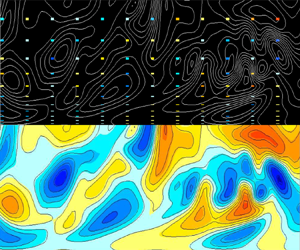Article contents
State estimation in turbulent channel flow from limited observations
Published online by Cambridge University Press: 22 April 2021
Abstract

Estimation of the initial state of turbulent channel flow from limited data is investigated using an adjoint-variational approach. The data are generated from a reference direct numerical simulation that is subsampled at different spatiotemporal resolutions. When the velocity data are at 1/4096 the spatiotemporal resolution of the direct numerical simulation, the correlation coefficient between the true and adjoint-variational estimated state exceeds 99 %. The robustness of the algorithm to observation noise is demonstrated. In addition, the impact of the spatiotemporal density of the data on estimation quality is evaluated, and a resolution threshold is established for a successful reconstruction. The critical spanwise data resolution is proportional to the Taylor microscale, which characterizes the domain of dependence of an observation location. Owing to mean advection, either the streamwise or temporal data resolution must satisfy a criterion based on the streamwise Taylor microscale. A second configuration is considered where the subsampled data comprise velocities in the outer layer and wall shear stresses only. The near-wall flow statistics and coherent structures, although not sampled, are accurately reconstructed, which is possible because of the coupling between the outer flow and near-wall motions. Finally, the most challenging configuration is addressed where only the spatiotemporally resolved wall stresses are observed. The estimation remains accurate within the viscous sublayer and deteriorates significantly with distance from the wall. In wall units, this trend is nearly independent of the Reynolds number considered, and is indicative of the fundamental difficulty of reconstructing wall-detached motions from wall data.
JFM classification
- Type
- JFM Papers
- Information
- Copyright
- © The Author(s), 2021. Published by Cambridge University Press
References
REFERENCES
- 27
- Cited by





